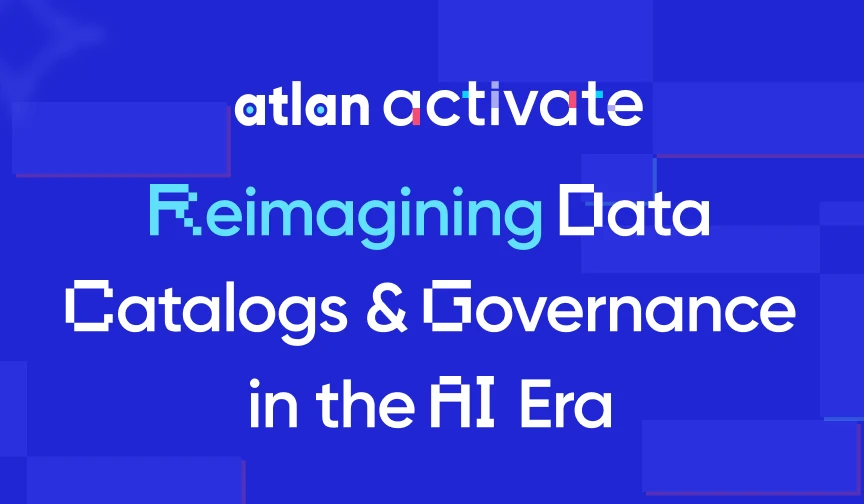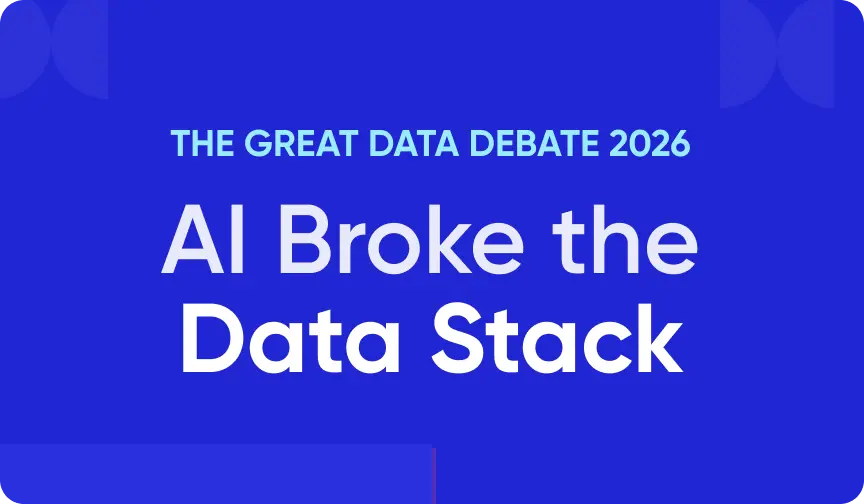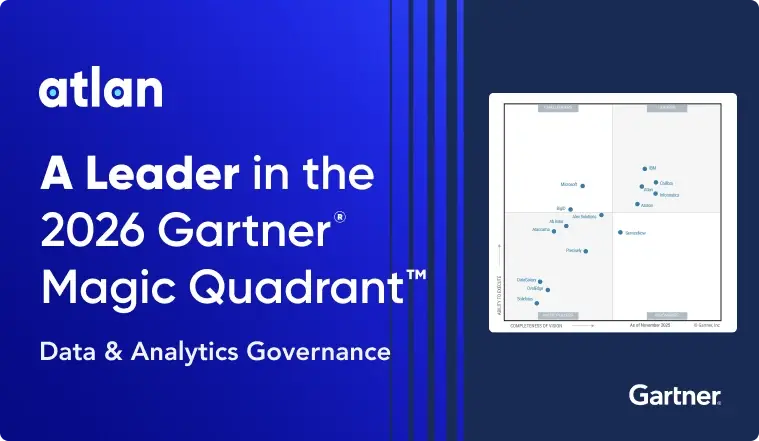Data Catalog Comparison: 6 Fundamental Factors to Consider
Share this article
The consulting firm McKinsey mentions recognizing the value of data as a must for becoming a data-driven enterprise of the future. Yet, many enterprises still struggle to leverage their data at scale, grappling with data silos and sprawls — when data collected is so vast that you don’t know what data you have, where you store it, or who owns it.
Fortunately, they’re solvable with the right data catalog. That’s why the data catalog comparison stage of your journey to becoming a data-driven enterprise is critical—a turning point that can either make or break your efforts.
Navigating this crucial phase requires an understanding of available data catalogs and factors to consider. This article will explore the factors crucial for effective data catalog comparison.
But before that, we’ll quickly look at the different types of data catalogs.
Table of contents
Permalink to “Table of contents”- Different types of catalogs
- How to compare data catalog tools
- The right data catalog builds modern data culture
- Related reads
Data catalog comparison: Understanding the different types of catalogs
Permalink to “Data catalog comparison: Understanding the different types of catalogs”With so many data catalogs on the market, which is the right one for your organization? Should you opt for open-source or enterprise-grade data catalogs? How do they weigh up against each other? Let’s quickly take stock:
- Open-source data catalogs have an obvious appeal. They are cheaper upfront and are, at least potentially, endlessly customizable. However, there are several hidden costs associated, and from a talent management perspective, they require experts to install, configure, customize, and maintain. Poor UI/UX and interoperability are also significant challenges you must tackle.
- Enterprise data catalogs come with frictionless UI, out-of-the-box connectors, and support for customization, setup, training, and maintenance. Moreover, next-generation catalogs (like Atlan) leverage AI and automation to help you scale your data management and governance efforts.
Choosing between open-source or enterprise data catalogs depends on your use cases, resource availability, and data stack maturity.
If you’re considering an enterprise data catalog, your data catalog comparison framework should include six critical capabilities. Let’s get into the specifics.
How to compare data catalog tools: 6 capabilities to consider
Permalink to “How to compare data catalog tools: 6 capabilities to consider”With several options in the marketplace, conducting a data catalog comparison and thoroughly evaluating the features and value of all available options can be intimidating.
Focus on these six capabilities to simplify the process of finding the right enterprise solution for your organization:
- Serves as a partner, not a vendor
- Leverages automation for faster time-to-value
- Ensures lineage for a single pane of glass
- Enhances adoption by data and business teams
- Provides configurability and flexibility for diverse teams and stacks
- Offers an extensible platform approach to leading the category
1. Serves as a partner, not a vendor
Permalink to “1. Serves as a partner, not a vendor”Every organization is different and has unique use cases for its data catalog. That’s why the ideal scenario is finding a solution provider who works with you to implement a customized data strategy that is scalable for your future needs.
A critical component to consider is your data architecture. For instance, if you are moving toward a next-generation architecture (data fabric or data mesh), you need a tool that works with your existing architecture and is adaptable for your future setup.
The data catalog should also scale as user adoption grows.
Your data catalog drives value, so don’t let it become expensive shelfware.
2. Leverages automation for faster time-to-value
Permalink to “2. Leverages automation for faster time-to-value”A key reason that catalog/governance projects fail is that it’s tedious (or impossible) to map the entire data estate and maintain accurate updated metadata for every asset, especially if most underlying processes are still largely manual.
That’s where automation can help with auto-ingestion of metadata, AI-suggested documentation (data asset definitions, descriptions, etc.), rule-based enrichment and tagging (using playbooks), intelligent search recommendations, and more.
McKinsey envisions a data enterprise of the future as one that uses AI-based tools to self-describe data (metadata and lineage), improve data quality, and generate scripts that facilitate safe and secure data access.
Dive deeper → 8 AI-powered data catalog workflows for the modern data enterprise
3. Ensures lineage for a single pane of glass
Permalink to “3. Ensures lineage for a single pane of glass”Many tools include ‘lineage,’ but not all data lineage is the same. Comprehensive data lineage unlocks data value by cleaning up the data estate. It fosters end-user trust, downstream impact analysis, and speedy resolution of pipeline issues.
If you’re scouting for a data catalog tool, pick one with automated, intuitive, actionable, column-level data lineage. Lineage provides maximum benefit when it functions at this level of granularity.
For instance, with column-level lineage, you’ll know exactly how a field in a table was created and when it was changed during the data transformation process.
Dive deeper → What can you do with column-level lineage?
When you combine automation and column-level lineage, you get a data catalog that eliminates grunt work — for instance, propagating data classification tags throughout your data hierarchy, ensuring all PII data is appropriately identified and masked.
For this purpose, the catalog must have out-of-the-box connectors that integrate with the most important tools in your present and future data stack.
4. Enhances adoption by data and business teams
Permalink to “4. Enhances adoption by data and business teams”Another major reason data catalog and data governance projects fail is that the tool is only used by the data engineering team. Your data catalog must be easy to use for all types of users.
Stakeholders across the value chain must see the data catalog as a one-stop shop for all things data.
But how do we get there? What features of a data catalog contribute to widespread adoption? Let’s have a look:
- Embedded in BI tools: Business teams are less likely to log in to systems that aren’t a part of their daily workflows. With embedded collaboration, you can encourage the business user to use and contribute to the data catalog without switching applications or even via browser extensions.
- Personalized user experience: While data analysts might want to see certified tables, data engineers might want to review data pipelines on a single dashboard. A big turn-off for users is when the data catalog is generic, preventing them from quickly accessing the right data with proper context. That’s where personalized user experiences, curated by user roles, business domains, or projects, can help.
- Natural language search: Business users must be able to discover data assets with the same ease as Googling for information online. The data catalog’s search functionality should support natural language search, include filters, provide role-based recommendations, and compile usage or popularity stats. This gives users all the information they need at a glance, leading to faster time-to-value.
- No-code querying: Technical know-how shouldn’t hinder data discovery and use. A catalog that enables no-code querying can help non-technical/business users find the data they want, while easing the load on your data engineering and data support teams.
- AI copilot: The modern data catalog also acts as an AI copilot — empowering business users to find data assets on their own, supporting data stewards with documentation at scale, offering natural language summaries of complex SQL transformations to data analysts, etc.
- Deep integrations with ticketing and communication tools: Seamless integration with tools like Slack and Jira helps users take action directly from the data catalog, such as asking questions of asset owners or logging engineering issues and support requests.
- Business glossary: A business glossary defines business terms across the enterprise, like a centralized knowledge bank. It’s also the key to data discovery, visibility, collaboration, and governance. It is the second brain for your business, helping you create connections between data, definitions, and domains that mimic how your business works.
Also, read → 15 data catalog features to look for
5. Provides configurability and flexibility for diverse teams and stacks
Permalink to “5. Provides configurability and flexibility for diverse teams and stacks”Your data catalog should support a diversity of users, use cases, and tools through a customized and personalized interface. For instance, it must help resolve divergent definitions for data assets, identify PII data, and find root causes of broken dashboards.
It should support custom metadata to capture metadata from any tool in your data stack. This could be metadata from your favourite orchestration tools, filters to further simplify data context, custom classifications and tags for different data types, and more.
6. Offers an extensible platform approach to leading the category
Permalink to “6. Offers an extensible platform approach to leading the category”The next-gen data catalog should be ready for mission-critical data projects like training AI models. To achieve this, firstly, you must ensure data readiness for AI.
Next, your development and data engineering teams must work with your data catalog partner to tap into the data catalog’s open, extensible architecture and introduce new capabilities quickly. Extensibility also means having the ability to build custom connectors.
Meanwhile, ensuring that the new data and metadata assets are comprehensible requires active metadata management, enabling a data ecosystem that’s always on, intelligent, and action-oriented.
Also, read → Modern data catalog: What they are, how they’ve changed, where they’re going
The right data catalog builds modern data culture
Permalink to “The right data catalog builds modern data culture”The right data catalog creates a positive and intentional data culture. That’s why the onus is on the data catalog comparison stage of your journey toward becoming a data-driven enterprise. The above factors will help you prioritize the capabilities that truly matter to your business.
Ultimately, you should opt for an implementation that serves your organization’s and your people’s needs. That means a data catalog with a rich, intuitive user experience that’s open, configurable, extensible, and flexible by default.
The data catalog is designed with governance as a core principle rather than an afterthought. Above all, the catalog is built by a team that will be your partner, heavily invested in your journey to data-driven decision-making.
Data catalog comparison: Related reads
Permalink to “Data catalog comparison: Related reads”- Data Catalog Guide: Examples, What to Look For, and Where They’re Going
- Alation vs Atlan: What Do Experts and Users Say?
- Alation vs. Collibra vs. Informatica vs. Atlan: A Comprehensive Comparison for Modern Data Needs
- AI Data Catalog: It’s Everything You Hoped For & More
- Data Catalog Pricing: Understanding What You’re Paying For
- Data Catalog Platform: The Key To Future-Proofing Your Data Stack
- 15 Essential Data Catalog Features to Look For in 2024
- Data Catalog Benefits: 5 Key Reasons Why You Need One
- 10 Data Catalog Best Practices All Data Teams Should Know
- Top Data Catalog Use Cases Intrinsic to Data-Led Enterprises
- Open Source Data Catalog: 5 Popular Tools to Consider in 2024
- Business Data Catalog: Users, Differentiating Features, Evolution & More
- Data Catalog for Business Outcomes: What Should You Consider Before Selecting the Right One?
- What is Active Metadata? — Definition, Characteristics, Example & Use Cases
Share this article





















